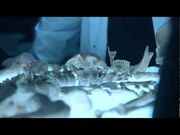
Richard III- King In The Car Park - Monday, 9pm - Channel 4
Richard III- King In The Car Park
From the Wikipedia page on Richard III - coverage on the topic is now here
On 24 August 2012, the University of Leicester and Leicester City Council, in association with the Richard III Society, announced that they had joined forces to begin a search for the remains of King Richard. Led by University of Leicester Archaeological Services (ULAS), experts set out to locate the lost site of the former Greyfriars Church (demolished during Henry VIII's dissolution of the monasteries), and to discover whether his remains were still interred there. The search located the Church of the Grey Friars, Leicester where Richard's body had been buried in 1485, beneath a modern-day city centre car park.
In parallel, the British historian John Ashdown-Hill used genealogical research to track down matrilineal descendants (descendants in the female line) of Anne St. Leger, Richard's only sororal niece, whose line of descent is still extant. A British-born woman who migrated to Canada after the Second World War, Joy Ibsen, was found to be a 16th-generation great-niece of the king. Although Ibsen died in 2008, her son Michael gave a mouth-swab sample to the research team on 24 August 2012. His mtDNA, passed down on the maternal side, can be used to compare samples from human remains from the excavation site, and potentially to identify King Richard.
On 5 September the excavators announced that they had identified the Greyfriars church[73] and two days later that they had identified the location of Robert Herrick's garden, where the memorial to Richard III stood in the early 17th century. Human bones were found beneath the church's choir. On 12 September it was announced that a skeleton discovered during the search might have belonged to Richard III. Five reasons were given: the body was of an adult male; it was buried beneath the choir of the church; there was severe scoliosis of the spine, possibly making one shoulder higher than the other (to what extent would depend on the severity of the condition). Additionally, there was an object that appeared to be an arrowhead embedded in the spine; and there were perimortem injuries to the skull. Dr. Jo Appleby, the archaeologist who discovered the skeleton, described the latter as "a mortal battlefield wound in the back of the skull"
On 4 February 2013, the University of Leicester confirmed that the skeleton was beyond reasonable doubt that of King Richard III. This conclusion was based on DNA evidence (including comparison with DNA from a 21st-century relative), soil analysis, and dental tests, as well as physical characteristics of the skeleton which are highly consistent with contemporary accounts of Richard's appearance. The team announced that the "arrowhead" discovered with the body was a Roman-era nail, probably disturbed when the body was first interred. However, there were numerous peri-mortem wounds on the body, and part of the skull had been sliced off with a bladed weapon. This would have caused rapid death. The team concluded that it is unlikely that the king was wearing a helmet in his last moments.
The Mayor of Leicester announced that the king's skeleton would be re-interred at Leicester Cathedral in early 2014, and by the same date King Richard III Visitor Centre opened in the Victorian school buildings next to the grave site.
See also Exhumation of Richard III of England